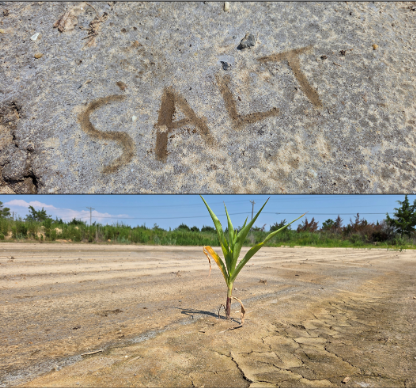
Fact Sheets And Publications
Where are Saline and Sodic Soils on Delmarva?
Written September 2025 | Written by: Jarrod Miller

Soil Salinity Classifications versus Crop Response
Soils affected by salts can be described in two ways: by salinity classification or by potential crop response (Figure 1). Salinity classifications are based on the total accumulation of salts in the soil, represented by electrical conductivity of the saturation extract (ECe; Table 1). If sodium (Na) is the dominant salt, additional measures such as the sodium adsorption ratio (SAR) or exchangeable sodium percentage (ESP) are used. Based on these measurements, soils are classified as saline, sodic, or saline-sodic (see our factsheet Salt Measurements and Soil Classifications for more information).
Crop responses are often tied directly to total salts, expressed as electrical conductivity of the saturated paste extract (ECe). Different crops vary widely in their tolerance: for example, corn yield can decline at ECe levels below the 4.0 dS/m threshold typically used to classify soils as saline, while barley can tolerate nearly twice that concentration without significant yield loss. These differences matter in the field. While soils classified as saline or sodic may be restricted to the lowest, frequently flooded areas, crop yield reductions can extend well beyond those zones.
Table 1: Classification of salt-affected soils in the USA saturated paste by electrical conductivity (ECe), sodium absorption ratio (SAR), exchangeable sodium percentage (ESP). Soils with a pH > 8.5 are sodic.
| Class | ECe (dS cm-1) | SAR | ESP |
|---|---|---|---|
| None | < 4.0 | < 13 | < 15 |
| Saline | > 4.0 | < 13 | < 15 |
| Sodic | <4.0 | > 13 | >15 |
| Saline Sodic | >4.0 | > 13 | >15 |
Maps of Saline, Sodic, and Saline-Sodic Soils on Delmarva
Six fields across Delmarva were grid-sampled for salinity (ECe) and sodicity (SAR) to identify areas classified as saline, sodic, or saline-sodic (Figure 2). Considerable variability occurred within each field, but one consistent factor was elevation: all affected soils were located below 2.3–3.0 feet above mean sea level. These zones often bordered tidal creeks, wetlands, or drainage ditches extending into the fields. Across sites, salinity classifications closely followed elevation contours (Figure 2), underscoring the strong influence of elevation on coastal salinity.

Two fields in the study contained only sodic soils. One was located along a tidally influenced ditch (field a), while the other bordered a drainage ditch leading into a wetland (field d). In field e, sodic soils were again mapped along a ditch but were positioned on the outer edges of saline-sodic soils, which dominated the immediate ditch banks. Field e was also the only site where all three classifications—sodic, saline, and saline-sodic—were observed together.
Saline-sodic soils were generally most prominent at low elevations and field edges. Fields c and f showed these soils near ditches and margins, with saline soils at their upper edges, suggesting strong influence from surface flooding. By contrast, field b, isolated from ditches and tidal waters, contained only saline soils, indicating the potential for groundwater-driven salinity.
Overall, soil sampling on coastal Delmarva farms showed that salt-affected soils are most common in low-lying areas near tidal influence, while inland fields are influenced more by shallow groundwater. Crop death sometimes occurred outside of these classified areas, highlighting that yield impacts can extend beyond mapped salt zones. Monitoring soil conditions in vulnerable areas is important for guiding crop management and maintaining soil health
This outreach was supported by USDA-NIFA: 2018-68002-27915..
References
Pokhrel, S, Blew, W., Miller, J.O., and Shober, A.L. (2025). Evaluating routine agronomic soil tests for coastal soil salinity detection in the Mid-Atlantic, Soil Science Society of America Journal, 89, e70075. https://doi.org/10.1002/saj2.70075
UD Cooperative Extension
This institution is an equal opportunity provider.
In accordance with Federal law and U.S. Department of Agriculture policy, Cooperative Extension is prohibited from discriminating on the basis of race, color, national origin, sex, age, or disability.
